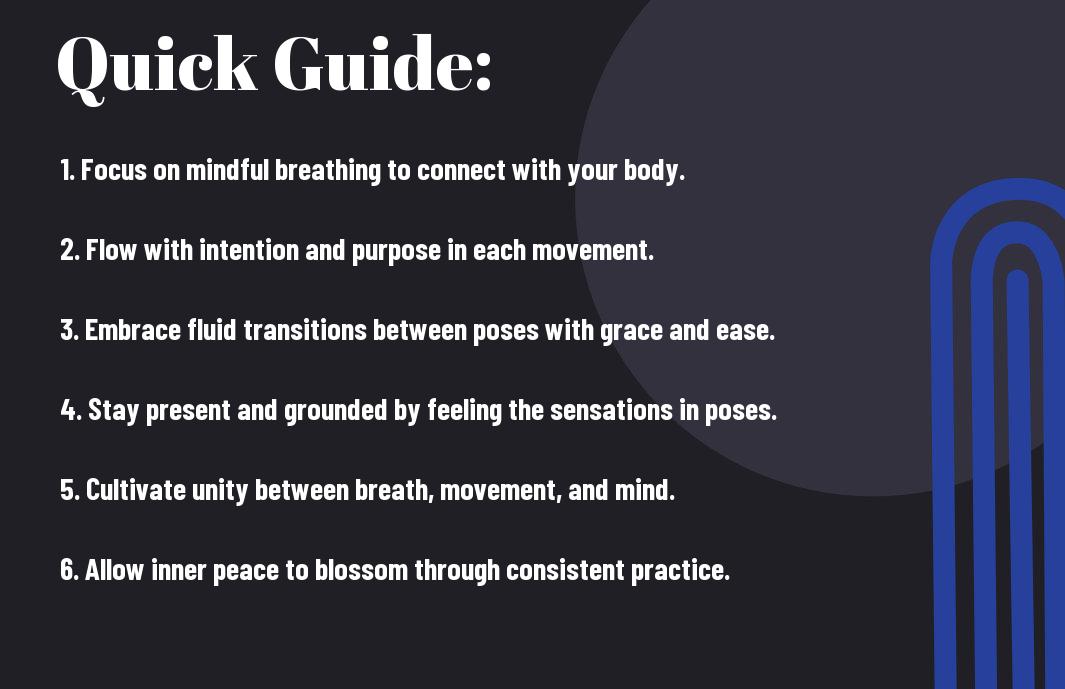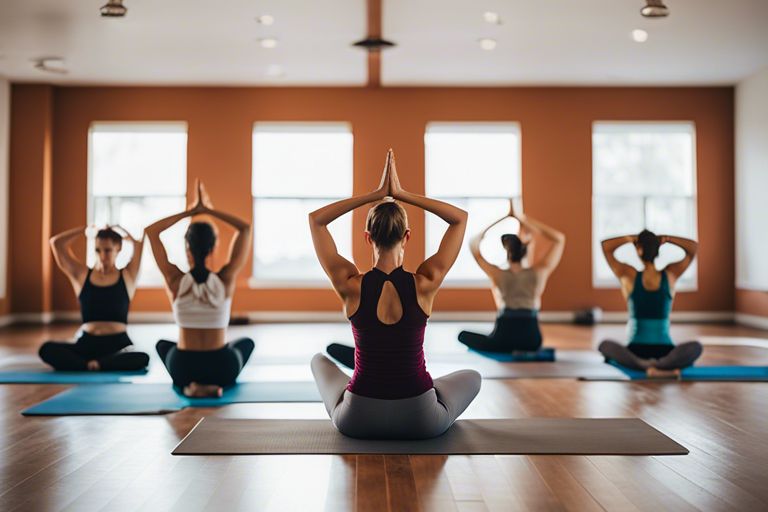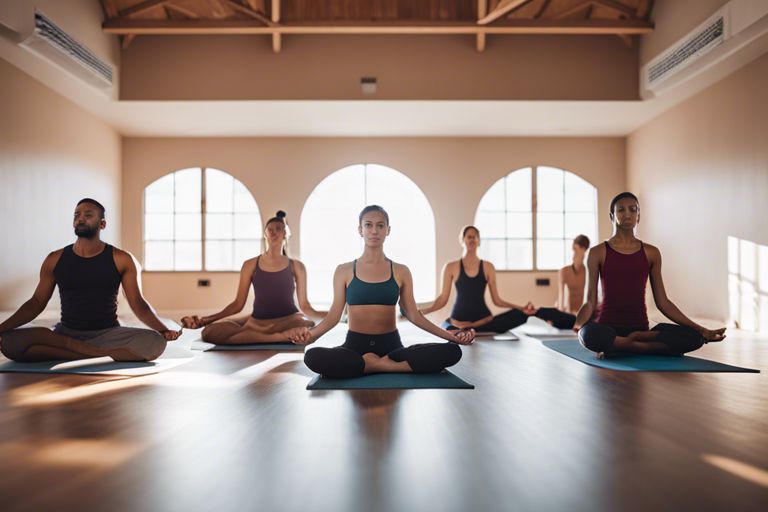This guide is designed to help you elevate your Vinyasa yoga practice by providing tips for finding unity and inner peace through movement. Vinyasa yoga is a dynamic practice that involves syncing the breath with movement, creating a flowing sequence of poses. By focusing on unity and inner peace during your practice, you can deepen your connection to mind, body, and soul. Let these tips guide you towards a more harmonious and fulfilling yoga journey.
Key Takeaways:
- Focus on your breath: Paying attention to your breath during vinyasa practice can help you stay present and connected to your body.
- Find unity in movement: Flowing through poses seamlessly and mindfully can create a sense of unity between your body and breath.
- Cultivate inner peace: Allow your vinyasa practice to be a moving meditation, helping you find stillness and tranquility within the flow of movement.

Understanding the Foundations of Vinyasa Yoga
Defining Vinyasa Yoga and Its Roots
One of the most popular styles of yoga practiced today, Vinyasa Yoga is a dynamic practice that synchronizes movement with breath to create a continuous flow. The word “Vinyasa” is derived from the Sanskrit term Nyasa, which means “to place,” and the prefix vi, which means “in a special way.” This combination emphasizes the mindful linking of movement and breath, leading to a seamless and harmonious practice.
The Importance of Breath, Bandha, and Drishti
Assuming the foundational elements of Vinyasa Yoga – breath, bandha, and drishti – is imperative for a transformative practice. Breath (Pranayama) acts as the life force that connects movement and meditation throughout the practice, fostering a sense of present moment awareness. Bandhas are internal energy locks that help to channel and cultivate prana (vital energy) within the body, providing stability and lightness in various postures. Drishti, or focused gaze, aids in concentration and balance, allowing the practitioner to turn their focus inward and find stillness amid movement.
For instance, paying attention to the alignment of the body, engaging in diaphragmatic breathing, and maintaining a steady gaze during challenging poses can enhance the overall experience of the practice, promoting a sense of unity between mind, body, and spirit.

Types of Vinyasa Yoga Practices
You may find various types of Vinyasa yoga practices that cater to different needs and preferences. Here’s a breakdown of some popular Vinyasa yoga styles:
| Hatha Vinyasa: A Traditional Approach | Ashtanga Vinyasa: A Fast-Paced Flow |
| Power Vinyasa: Building Strength and Endurance | Restorative Vinyasa: A Gentle and Therapeutic Approach |
Hatha Vinyasa: A Traditional Approach
An vital foundation for Vinyasa yoga, Hatha Vinyasa focuses on aligning breath with movement. This practice emphasizes holding poses to improve strength, flexibility, and balance. It is a great place for beginners to start before delving into more dynamic styles of Vinyasa yoga.
Ashtanga Vinyasa: A Fast-Paced Flow
Vinyasa in Ashtanga yoga refers to the synchronization of breath with a continuous flow of postures. This style is characterized by a fast-paced, intense practice that follows a specific sequence of poses. Ashtanga Vinyasa yoga is physically challenging and helps build strength, flexibility, and stamina.
After setting a consistent practice, yogis may experience greater mental focus and clarity in their daily lives. For more detailed information on the benefits of mindfulness in yoga, check out Yoga and Mindfulness: Cultivating Presence On and Off the Mat.
Power Vinyasa: Building Strength and Endurance
Flow: Power Vinyasa yoga is a vigorous and challenging style that focuses on building strength, endurance, and flexibility. This dynamic practice often includes intense sequences of poses that flow together seamlessly, creating a powerful and energizing experience.
Strength: Regular practice of Power Vinyasa can help you develop both physical and mental strength, as you push your boundaries and explore your edge on the mat. It can be a great way to challenge yourself and take your practice to the next level.
Restorative Vinyasa: A Gentle and Therapeutic Approach
The Restorative Vinyasa style offers a gentle and therapeutic approach to Vinyasa yoga. It focuses on relaxing the body, calming the mind, and restoring balance. This practice incorporates supported poses, deep breathing, and mindfulness to help release tension and promote deep relaxation.
Tips for Enhancing Your Vinyasa Yoga Practice
Not only does Vinyasa yoga offer physical benefits like increased flexibility, strength, and balance, but it also provides a pathway to inner peace and unity of mind, body, and spirit. To elevate your Vinyasa practice, consider the following tips:
- Developing a Consistent Practice Schedule
- Creating a Conducive Practice Environment
- Focusing on Proper Alignment and Technique
- Cultivating Mindfulness and Awareness
Developing a Consistent Practice Schedule
If you want to deepen your Vinyasa practice, setting a consistent schedule is important. By dedicating specific times during the week to your practice, you create a routine that helps you stay committed and focused. Consistency also allows your body and mind to adapt and progress more effectively. For more insights on how to unlock inner peace through Vinyasa yoga, check outUnlocking Inner Peace: A Journey Through Vinyasa Yoga.
Creating a Conducive Practice Environment
Creating a space that is conducive to your practice can significantly enhance your Vinyasa experience. Choose a quiet and clutter-free area where you can move freely without distractions. It is important to have a clean, peaceful environment that promotes focus and relaxation. Practicing in a welcoming space can help you connect more deeply with your breath and body, fostering a sense of tranquility and mindfulness.
It is crucial to eliminate any potential disturbances that may interrupt your practice. Keeping your practice area organized and soothing can create a harmonious atmosphere that allows you to fully immerse yourself in the flow of Vinyasa.
Focusing on Proper Alignment and Technique
For a more fulfilling Vinyasa practice, pay attention to proper alignment and technique. Aligning your body correctly in each pose not only prevents injuries but also ensures that you receive the full benefits of the practice. Focus on engaging the right muscles, maintaining a steady breath, and moving mindfully through transitions. Practice with awareness and intention to refine your alignment and deepen your connection to each movement.
Practice with proper alignment not only enhances the physical aspects of your practice but also helps you cultivate a greater sense of body awareness and presence on the mat. By being mindful of your alignment, you can prevent strain and injury while fostering a deeper mind-body connection.
Cultivating Mindfulness and Awareness
With Vinyasa yoga, mindfulness and awareness are key components that elevate the practice beyond just physical movements. By staying present in each breath and each pose, you can tap into a deeper level of consciousness that promotes inner peace and unity. Understanding the connection between your breath and movement allows you to synchronize your actions with your intentions, creating a harmonious flow of energy throughout your practice.
Understanding the importance of mindfulness and awareness can transform your practice into a moving meditation that brings a profound sense of tranquility and clarity. By cultivating these qualities on the mat, you not only enhance your Vinyasa practice but also carry these skills into your daily life, promoting a more mindful and peaceful existence.
A Step-by-Step Guide to Mastering Vinyasa Yoga Poses
After learning the foundational principles of Vinyasa yoga, mastering the poses takes practice and dedication. Here is a step-by-step guide to help you develop proficiency in various yoga poses:
| Foundational Standing Poses | Balancing and Strengthening Poses |
| Mountain Pose | Eagle Pose |
| Tree Pose | Triangle Pose |
| Warrior Pose | Side Plank Pose |
Foundational Standing Poses: Mountain, Tree, and Warrior
If you are new to Vinyasa yoga, starting with foundational standing poses like Mountain, Tree, and Warrior can help you build strength and stability. Mountain Pose (Tadasana) teaches you how to ground yourself and find alignment in your body. Tree Pose (Vrikshasana) challenges your balance and focus, while Warrior Poses (Virabhadrasana) cultivate strength and flexibility in the legs and core.
Balancing and Strengthening Poses: Eagle, Triangle, and Side Plank
Strengthening your body and improving balance is imperative in Vinyasa yoga. Poses like Eagle, Triangle, and Side Plank not only build physical strength but also enhance mental focus and coordination. Eagle Pose (Garudasana) targets the arms and legs, while Triangle Pose (Trikonasana) stretches the torso and strengthens the legs. Side Plank Pose (Vasisthasana) tones the arms, core, and legs, helping you develop overall body awareness.
Foundational Standing and Balancing Poses are crucial for developing a strong yoga practice. These poses not only help in physical alignment but also aid in mental concentration and breath control. Integrating these poses into your regular practice will lay a solid foundation for more advanced postures.
Seated and Forward-Folding Poses: Seated Forward Fold and Headstand
Seated and forward-folding poses provide a different perspective on alignment and flexibility. Seated Forward Fold (Paschimottanasana) stretches the back body and hamstrings, promoting relaxation and introspection. Headstand (Sirsasana), often called the king of yoga poses, builds upper body strength and improves blood circulation to the brain, enhancing focus and clarity of mind.
Seated poses help in calming the mind and releasing tension from the body by focusing on forward folds and introspection. These poses are beneficial for improving flexibility in the spine and hamstrings, as well as enhancing overall relaxation.
Inversions and Restorative Poses: Shoulder Stand and Legs Up the Wall
Little Guide to mastering inversions and restorative poses like Shoulder Stand and Legs up the Wall can bring a new dimension to your practice. Shoulder Stand (Sarvangasana) improves circulation and strengthens the shoulders and core. Legs Up the Wall Pose (Viparita Karani) is a gentle inversion that promotes relaxation, reduces swelling in the legs, and helps in calming the nervous system.
Poses like Shoulder Stand and Legs Up the Wall offer a unique way to experience the benefits of inversions and restorative poses. These poses can help to relieve stress, improve circulation, and promote a sense of calm and well-being in the body and mind.
Factors to Consider for a Safe and Effective Practice
Unlike other forms of exercise, Vinyasa Yoga involves dynamic movements that flow from one pose to another, emphasizing the connection between breath and movement. To ensure a safe and effective practice, it is vital to consider the following factors:
- Modifying poses for injuries and limitations
- Understanding and managing energy levels and fatigue
- The role of diet and nutrition in supporting your practice
- The importance of listening to your body and honoring its limits
Modifying Poses for Injuries and Limitations
Even if you have limitations or are recovering from an injury, you can still enjoy the benefits of Vinyasa Yoga by modifying poses to suit your needs. It’s crucial to communicate with your instructor about your condition to receive appropriate guidance. With modifications, you can safely practice and gradually improve your strength and flexibility Any.
Understanding and Managing Energy Levels and Fatigue
One of the keys to a successful Vinyasa Yoga practice is understanding how to manage your energy levels and fatigue. It’s vital to listen to your body and know when to push yourself and when to rest. Plus, incorporating mindfulness techniques can help you stay present and connected during your practice, enhancing the overall experience and benefits.
The Role of Diet and Nutrition in Supporting Your Practice
Factors such as hydration and nutrient-rich foods play a significant role in supporting your Vinyasa Yoga practice. Energy levels and performance can be influenced by what you eat and drink before and after a session. Energy in the form of carbohydrates and proteins can help fuel your practice and aid in muscle recovery.
The Importance of Listening to Your Body and Honoring Its Limits
You must pay attention to signals from your body during your Vinyasa Yoga practice. Ignoring pain or discomfort can lead to injury, while honoring your body’s limits can help prevent setbacks and promote progress. This self-awareness and mindfulness are fundamental in creating a safe and sustainable practice.
Weighing the Pros and Cons of Vinyasa Yoga
To better understand the practice of Vinyasa yoga, it’s important to weigh the pros and cons that come with it. Here we break down the benefits and potential drawbacks of engaging in this dynamic form of yoga.
| Pros | Cons |
| Improves flexibility | Potential for injuries |
| Strengthens muscles | Risk of burnout |
| Enhances balance | Unrealistic expectations |
Physical Benefits: Flexibility, Strength, and Balance
Benefits of Vinyasa yoga include improved flexibility, as the flowing sequences help to stretch and lengthen muscles. The practice also builds strength, particularly in the core and upper body, through various poses like Plank and Chaturanga. Additionally, Vinyasa promotes balance by incorporating standing poses and transitions that challenge stability.
Mental and Emotional Benefits: Reduced Stress and Anxiety
Anxiety can be alleviated through Vinyasa yoga, as the focus on breath and movement helps to calm the mind and reduce stress levels. The meditative aspect of the practice encourages mindfulness and presence, which can be beneficial for those dealing with anxiety or racing thoughts.
Benefits of Vinyasa yoga extend to mental and emotional well-being, with the practice offering a holistic approach to stress reduction and anxiety management. The synchronization of breath with movement creates a moving meditation that can quiet the mind and promote emotional balance.
Potential Drawbacks: Injuries, Burnout, and Unrealistic Expectations
An important consideration when practicing Vinyasa yoga is the potential for injuries, especially if proper alignment and modifications are not followed. Pushing too hard or moving too quickly can lead to strain or overuse injuries. Additionally, the fast-paced nature of Vinyasa can sometimes contribute to burnout if practitioners do not listen to their bodies’ needs.
Drawbacks of Vinyasa yoga may include setting unrealistic expectations for oneself, such as striving for perfection in poses or progress. This can create unnecessary pressure and detract from the inherent benefits of the practice.
Finding a Balance Between Challenge and Self-Care
Weighing the challenges and rewards of Vinyasa yoga involves finding a balance between pushing oneself to grow and respecting the body’s limits. It’s vital to practice mindfulness and self-awareness to prevent injuries and burnout while still experiencing the transformative effects of the practice.
Balance is key in Vinyasa yoga, as it allows practitioners to harness the physical and mental benefits of the practice without compromising their well-being. By striking a balance between challenge and self-care, individuals can cultivate strength, flexibility, and inner peace through their Vinyasa practice.
To wrap up
Presently, by incorporating the tips mentioned above into your vinyasa yoga practice, you can enhance both your physical movements and mental awareness. Focus on your breath, move mindfully through transitions, and practice gratitude to find unity within yourself and the world around you. Remember that unity and inner peace can be achieved through the simple act of moving with intention and awareness.
Take these suggestions with you to your next vinyasa yoga class and notice the difference it makes in your practice. Let go of perfectionism and instead focus on finding unity and inner peace through movement. Embrace the journey and enjoy the positive impact it can have on your physical, mental, and spiritual well-being.
FAQ
Q: What is Vinyasa Yoga?
A: Vinyasa Yoga is a style of yoga that focuses on the coordination of breath and movement. It involves a series of flowing sequences that smoothly transition from one pose to another, creating a meditative and dynamic practice.
Q: How can I elevate my Vinyasa Yoga practice?
A: To elevate your Vinyasa Yoga practice, you can focus on finding unity and inner peace through movement. This can be achieved by being mindful of your breath, listening to your body, and staying present in each moment on the mat.
Q: What are some tips for finding unity and inner peace in Vinyasa Yoga?
A: Some tips for finding unity and inner peace in Vinyasa Yoga include setting an intention for your practice, connecting with your breath, maintaining proper alignment in poses, and practicing gratitude and self-compassion throughout your practice.











